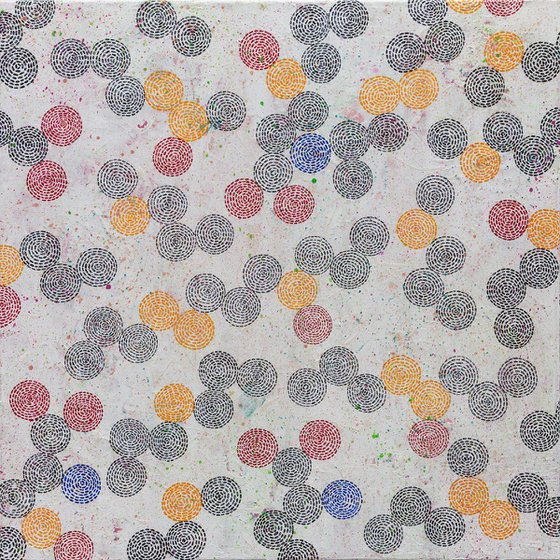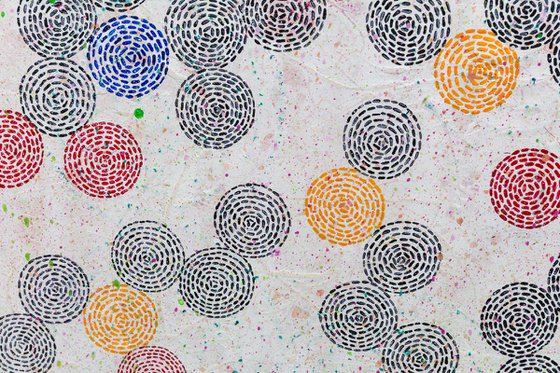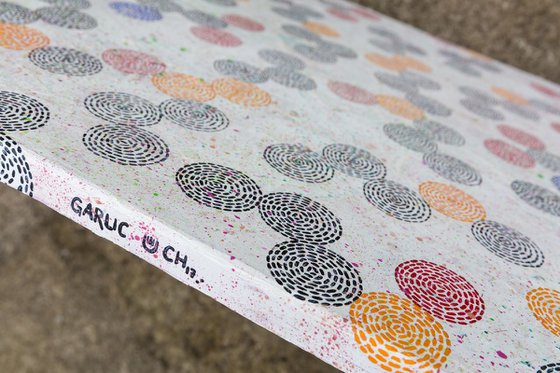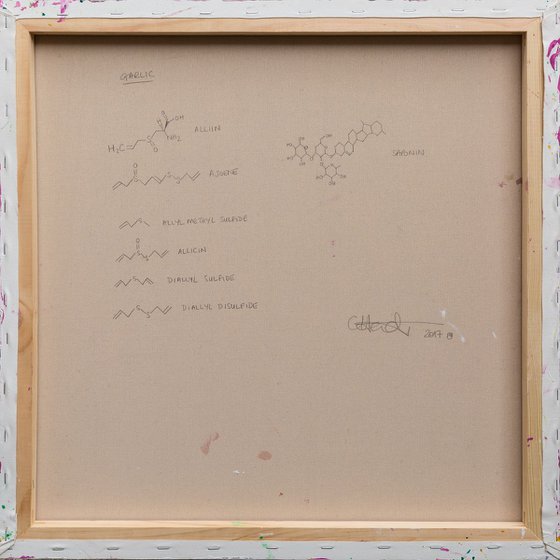Original artwork description:
Abstract painting of some of the molecules that give garlic its flavour and odour.
A large number of sulphur compounds contribute to the smell and taste of garlic. Allicin has been found to be the compound most responsible for the “hot” sensation of raw garlic. The process of cooking garlic removes allicin, thus mellowing its spiciness. Allicin, along with its decomposition products diallyl disulfide and diallyl trisulfide, are major contributors to the characteristic odor of garlic, with other allicin-derived compounds, such as vinyldithiins and ajoene. When eaten in quantity, garlic may be strongly evident in the diner’s sweat and garlic breath the following day. This is because garlic’s strong-smelling sulphur compounds are metabolized, forming allyl methyl sulfide. Allyl methyl sulfide (AMS) cannot be digested and is passed into the blood. It is carried to the lungs and the skin, where it is excreted. Since digestion takes several hours, and release of AMS several hours more, the effect of eating garlic may be present for a long time.
Saponin - The painting has been created in layers, with the large saponin molecule forming a base layer. Saponins are found in garlic, and are found to have anti-fungal, anti-bacterial and anti-inflammatory properties. They have also been shown to reduce levels of cholesterol in the blood.
The colour of each circle (each representing an atom) relates to the element shown, eg yellow is Sulphur, red is Oxygen, blue is Nitrogen and black is Carbon.
Materials used:
acrylic, enamel on canvas
Tags:
#white #black #circles #dots #garlic #aboriginal art #scientific art #molecules #molecular artGarlic (2017)
Acrylic painting
by Catherine Hadler
1 Artist Reviews
£495
- Acrylic painting on Canvas
- One of a kind artwork
- Size: 60 x 60 x 2cm / 60 x 60cm (actual image size)
- Ready to hang
- Signed on the back
- Style: Geometric
- Subject: Abstract and non-figurative
Original artwork description
Abstract painting of some of the molecules that give garlic its flavour and odour.
A large number of sulphur compounds contribute to the smell and taste of garlic. Allicin has been found to be the compound most responsible for the “hot” sensation of raw garlic. The process of cooking garlic removes allicin, thus mellowing its spiciness. Allicin, along with its decomposition products diallyl disulfide and diallyl trisulfide, are major contributors to the characteristic odor of garlic, with other allicin-derived compounds, such as vinyldithiins and ajoene. When eaten in quantity, garlic may be strongly evident in the diner’s sweat and garlic breath the following day. This is because garlic’s strong-smelling sulphur compounds are metabolized, forming allyl methyl sulfide. Allyl methyl sulfide (AMS) cannot be digested and is passed into the blood. It is carried to the lungs and the skin, where it is excreted. Since digestion takes several hours, and release of AMS several hours more, the effect of eating garlic may be present for a long time.
Saponin - The painting has been created in layers, with the large saponin molecule forming a base layer. Saponins are found in garlic, and are found to have anti-fungal, anti-bacterial and anti-inflammatory properties. They have also been shown to reduce levels of cholesterol in the blood.
The colour of each circle (each representing an atom) relates to the element shown, eg yellow is Sulphur, red is Oxygen, blue is Nitrogen and black is Carbon.
Materials used:
acrylic, enamel on canvas
Tags:
#white #black #circles #dots #garlic #aboriginal art #scientific art #molecules #molecular artReturns and refunds
We want you to love your art! If you are not completely satisfied with your purchase you can return it free within 14 days, no questions asked. Learn more
Artist Reviews (1)
This artwork is sold by Catherine Hadler from United Kingdom






